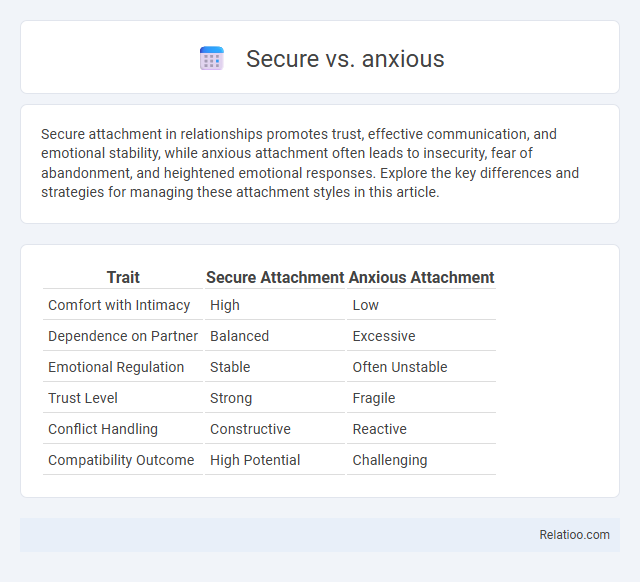Secure attachment in relationships promotes trust, effective communication, and emotional stability, while anxious attachment often leads to insecurity, fear of abandonment, and heightened emotional responses. Explore the key differences and strategies for managing these attachment styles in this article.
Table of Comparison
| Trait | Secure Attachment | Anxious Attachment |
|---|---|---|
| Comfort with Intimacy | High | Low |
| Dependence on Partner | Balanced | Excessive |
| Emotional Regulation | Stable | Often Unstable |
| Trust Level | Strong | Fragile |
| Conflict Handling | Constructive | Reactive |
| Compatibility Outcome | High Potential | Challenging |
Understanding Attachment Styles: Secure vs Anxious
Secure attachment style is characterized by comfort with intimacy and trust in relationships, promoting emotional stability and effective communication. Anxious attachment style involves a heightened need for closeness and fear of abandonment, often leading to dependency and emotional volatility. Understanding these styles aids in recognizing relationship patterns and improving emotional regulation and interpersonal dynamics.
Core Traits of Secure Attachment
Secure attachment is characterized by trust, emotional regulation, and effective communication in relationships. Individuals with secure attachment exhibit high self-esteem, comfort with intimacy, and resilience to stress. This attachment style fosters healthy interpersonal connections and adaptive coping mechanisms.
Key Features of Anxious Attachment
Anxious attachment is characterized by heightened sensitivity to rejection and fear of abandonment, often leading to excessive reassurance-seeking and emotional volatility. Individuals with this attachment style display a persistent need for closeness combined with worry about their partner's responsiveness. This pattern can result in difficulties managing trust and maintaining secure, stable relationships.
How Secure and Anxious Styles Form
Secure attachment develops through consistent, responsive caregiving that meets Your emotional needs, fostering trust and confidence in relationships. Anxious attachment often forms when caregivers are unpredictable or inconsistent, leading to insecurity and heightened sensitivity to rejection. These early interactions shape how individuals perceive and respond to intimacy and stress throughout life.
Common Triggers for Each Attachment Type
Common triggers for secure attachment include neglect or inconsistency, which can challenge your trust but are typically managed with resilience. Anxious attachment is often triggered by perceived rejection, abandonment, or lack of reassurance, leading to heightened emotional responses and fear of loss. Avoidant attachment commonly responds to emotional closeness or vulnerability, causing withdrawal and discomfort in intimate situations.
Emotional Responses in Relationships
Secure attachment style involves balanced emotional responses, allowing you to communicate needs openly and manage conflicts calmly. Anxious attachment triggers heightened emotional sensitivity, causing worry about rejection and intense need for reassurance. Understanding these styles helps regulate your emotional reactions and fosters healthier interpersonal connections.
Communication Patterns: Secure vs Anxious
Secure attachment fosters clear, honest communication with balanced emotional expression, allowing you to navigate conflicts calmly and build trust. Anxious attachment often triggers excessive reassurance-seeking, misinterpreting neutral messages as threats, which can escalate misunderstandings. Developing awareness of these patterns enhances relationship dynamics by promoting more effective dialogue and emotional regulation.
Navigating Conflict: Strategies for Both Styles
Secure attachment fosters open communication and empathy during conflicts, promoting resolution through mutual understanding and trust. Anxious attachment often triggers heightened sensitivity and fear of abandonment, requiring reassurance and active listening to de-escalate tensions. Effective conflict navigation combines patience with clear boundary-setting to address both the need for security and emotional expression.
Impact on Long-Term Relationship Satisfaction
Secure attachment fosters trust and open communication, significantly enhancing long-term relationship satisfaction by promoting emotional stability and mutual support. Anxious attachment often leads to insecurity and fear of abandonment, which can strain relationships and reduce overall satisfaction. Understanding your attachment style helps improve relationship dynamics and fosters healthier, more fulfilling partnerships.
Moving Towards Secure Attachment
Moving towards secure attachment involves cultivating trust, emotional regulation, and healthy boundaries, which reduces anxiety and avoidance in relationships. Secure attachment fosters open communication, consistent support, and balanced dependence that strengthens interpersonal connections. Developing self-awareness and practicing empathy help individuals transition from anxious or avoidant styles to a secure attachment framework.

Infographic: Secure vs Anxious
 relatioo.com
relatioo.com